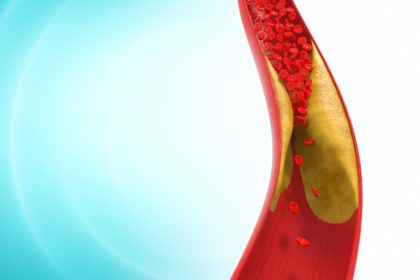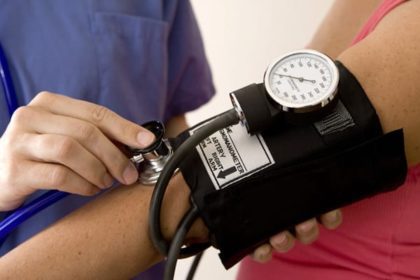Atrial fibrillation, also called AFib or AF, is the most common irregular heart rhythm in the United States where 2.7 to 6.1 million Americans are living with this dangerous condition. Here’s AFib explained, the risks, and how this one food affects these abnormal heart beats.

What is Atrial Fibrillation?
Atrial fibrillation (AFib) is an irregular heart rhythm caused by abnormal electrical signals in the upper chambers of the heart.
AFib is on the rise because the older you are, the greater the risk of developing AFib. Finding effective ways to prevent AFib and identify treatments for AFib is a public health priority.
Typically someone one with AFib has to take a blood-thinner to prevent blood clots from forming and reduce stroke risk. Blood thinners can have dangerous side effects, such as severe bleeding, coughing up blood, bruising without an injury, and dizziness.
High Blood Pressure Link
If you have high blood pressure, AFib needs to be on your radar. People with high blood pressure (which usually occurs with advancing age) accounts for 14% to 22% of AFib cases.
Health Effects from Atrial Fibrillation (AFib)
Atrial fibrillation is dangerous. It is a risk factor for:
- Stroke — 4 to 5 times higher risk compared with people without AFib. Strokes caused by AFib complications tend to be more severe than strokes with other underlying causes.
- Heart failure — AFib decreases coronary blood flow.
- Cognitive decline and dementia — One gallon of blood goes through your brain every four minutes. If blood flow is impaired such as from AFib, brain function suffers. Persistent AFib decreases blood flow to the brain.
- Death

AFib Symptoms
Some people don’t have any symptoms, but many experience one or more of the following:
- Irregular heart beat (feels like your heart is skipping beats)
- Heart palpitations (racing, fluttering, or pounding)
- Lightheadedness
- Extreme fatigue / discomfort
- Shortness of breath
- Chest pain / sweating (mimicking a heart attack)
The Chocolate Study
 A large study led by researchers in Denmark analyzed the dietary habits and health conditions of a large database of over 55,000 men and women aged 50-64 years old who were participating in the Danish Diet, Cancer, and Health Study.
A large study led by researchers in Denmark analyzed the dietary habits and health conditions of a large database of over 55,000 men and women aged 50-64 years old who were participating in the Danish Diet, Cancer, and Health Study.
During a period of 13.5 years, the researchers found over 3,300 cases of atrial fibrillation. When they examined the chocolate consumption habits, they found an association between eating moderate amounts of chocolate and significantly lower risk of atrial fibrillation.

Results
The rates of AFib were compared to the amounts of chocolate consumed. The following results were compared to those who ate a one-ounce serving (30 grams) less than once a month. They found AFib risk was:
- 10% lower for people who ate 1 to 3 servings per month
- 17% lower for people who ate 1 serving per week
- 20% lower for people who ate 2 to 6 servings per week
- 16% lower for people who ate 1 or more servings per day (Further research is needed to confirm whether high levels of chocolate consumption are associated with higher AF risk.)
Plant Compounds in Chocolate
UPDATE: Chocolate contains high levels of flavanols (“FLAY-va-nole”) — an antioxidant that reduces inflammation and dilates (widens) blood vessels. Eating moderate amounts of cocoa and cocoa-containing foods may promote cardiovascular health due to their high content of flavanols (a subgroup of polyphenols). Flavanols have vasodilatory, antioxidant, and anti-inflammatory benefits. Darker chocolate versus milk chocolate contains more flavanols.
Evidence suggests that AFib involves an inflammatory cascade of events. Higher levels of inflammation may result in damage to the endothelium (inner lining of the artery) and other cellular events that lead to electrical and structural changes in the heart (i.e., the atrial tissue) that increase risk of atrial fibrillation.
The hypothesis: The anti-inflammatory and antiplatelet benefits of cocoa may be associated with a lower rate of AFib.
Type of Chocolate Used
In the study, the questionnaire did not differentiate between milk and dark chocolate, but most of the chocolate consumed in Denmark is MILK chocolate. Unlike the U.S. where milk chocolate is 10% cacao, milk chocolate in Denmark must have a minimum of 30% cacao and dark chocolate must contain a minimum of 43% cacao.
Most of the chocolate consumed in the sample probably contained relatively LOW concentrations of flavanols. But even so, the association between decreased rate of AFib incidents and chocolate intake was significant.
![]() Karen’s Fit Tip: Eat the darker chocolate for more flavanols, but don’t eat more than one serving a day — and definitely don’t eat a serving EVERY day. Remember… many chocolates are high in calories, so eating a lot of it can negate the health benefits by leading to weight gain and diabetes.
Karen’s Fit Tip: Eat the darker chocolate for more flavanols, but don’t eat more than one serving a day — and definitely don’t eat a serving EVERY day. Remember… many chocolates are high in calories, so eating a lot of it can negate the health benefits by leading to weight gain and diabetes.

xo





